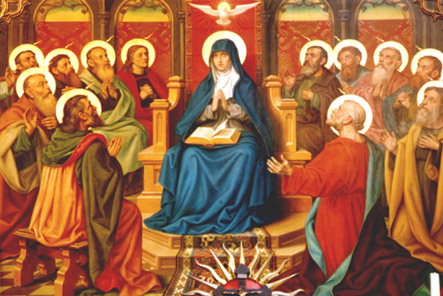
Of all the seasons of the liturgical year Eastertide is by far the richest in mystery. We might even say that Easter is the summit of the Mystery of the Sacred Liturgy. The Christian who is happy enough to enter with his whole mind and heart into the knowledge and love of the Paschal Mystery, has reached the very center of the supernatural life.
During these days we have brought before us the two great manifestations of God's goodness towards mankind – the Pasch of Israel and the Christian Pasch; the Pentecost of Sinai and the Pentecost of the Church. We shall have occasion to show how the ancient figures were fulfilled in the realities of the new Easter and Pentecost, and how the twilight of the Mosaic Law made way for the full daylight of the Gospel; but we cannot resist the feeling of holy reverence, at the bare thought that the solemnities we have now to celebrate are more than 3,000 years old, and that they are to be renewed every year till the voice of the angel shall be heard proclaiming: "Time shall be no more!" (Apoc. 10: 6)
Eternity in Heaven is the true Pasch: hence, our Pasch on earth is the Feast of feasts. The holy Fathers bid us look on these 50 days of Easter as the image of our eternal happiness. They are days devoted exclusively to joy; every sort of sadness is forbidden; and the Church cannot speak to her divine Spouse without joining to her words that glorious cry of Heaven, the Alleluia, wherewith, as the holy Liturgy says, the streets and squares of the heavenly Jerusalem resound without ceasing.
We have already explained why Our Savior chose Sunday for His Resurrection – it was on this favored day that He had created the light; by selecting it now for the commencement of the new life which He graciously imparts to man, He would show us that Easter is the renewal of the entire creation. Every Sunday throughout the year is to be a sort of Easter, a holy and sacred day. The Synagogue, by God's command, kept holy the Sabbath in honor of God's resting after the six days of creation; but the Church, the Spouse of Christ, is commanded to honor the work of her Lord. She allows Saturday to pass – it is the day on which Her Jesus rested in the sepulchre: but now that She is illuminated with the brightness of the Resurrection, She devotes to the contemplation of His work the first day of the week; it is the day of light, for on it He called forth material light, and on it He that is the Light of the World rose from the darkness of the tomb.
Let then the week with its Sabbath pass by; what we Christians want is the eighth day, the day that is beyond the measure of time, the day of eternity, the day whose light is not intermittent or partial, but endless and unlimited. Thus speak the holy Fathers, when explaining the substitution of Sunday for Saturday. "Let us," says the pious Abbot Rupert, "leave the Jews to enjoy the ancient Sabbath, which is a memorial of the visible creation… They would not recognize this world's Creator as their king, because He said, 'Blessed are the poor!' and 'Woe to the rich!' But our Sabbath has been transferred from the seventh to the eighth day, and the eighth is the first. And rightly was the seventh changed into the eighth, because we Christians put our joy in a better work than the creation of the world…"
The mystery of the seventh followed by an eighth day, as the holy one, is again brought before us by the number of weeks which form Paschal tide. These weeks are seven; they form a week of weeks, and their morrow is again a Sunday, the glorious feast of Pentecost. These mysterious numbers – which God Himself fixed when He instituted the first Pentecost after the first Passover – were adopted by the Apostles when they regulated the Christian Easter. Another figure of our Eastertide was the year of Jubilee, which God bade Moses prescribe to his people. Each 50th year the houses and lands that had been alienated during the preceding 49 had to be returned to their original owners; and those Israelites who had been compelled by poverty to sell themselves as slaves recovered their liberty. This year, which was properly called the sabbatical year, was the sequel of the preceding seven weeks of years, and was thus the image of our eighth day, whereon the Son of Mary, by His Resurrection, redeemed us from the slavery of the tomb, and restored us to the inheritance of our immortality.
The rites peculiar to Eastertide, in the present discipline of the Church, are two: the unceasing repetition of the Alleluia, of which we have already spoken, and the color of the vestments used for its two great solemnities. White is appropriate to the Resurrection: it is the mystery of eternal light, which knows neither spot nor shadow; it is the mystery that produces in a faithful soul the sentiment of purity and joy. Pentecost, which gives us the Holy Ghost, the consuming Fire (Hebr. 12: 29), is symbolized by the red vestments, which express the mystery of the Divine Paraclete coming down in the form of fiery tongues upon them that were assembled in the Cenacle.
Contact us: smr@salvemariaregina.info
Visit also: www.marienfried.com